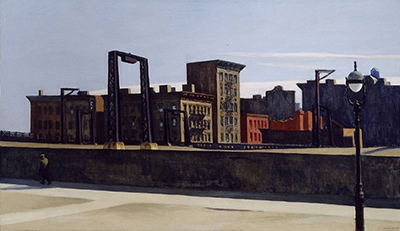Edward Hopper painted Manhattan Bridge Loop in 1928
He lived in New York City for over fifty decades and a vast majority of his work is a collection of urban scenes of a city he knew extremely well.
Hopper was a man with a solitary personality and a strong inner life.
His paintings are a very powerful expression of his perception of the modern world and the subjects on The City in particular are impressive depictions of human isolation in a world that keeps moving forward yet leaves human feelings behind.
Meaning in the Composition
Hopper’s love for theatre and film is apparent in the arrangement of the objects in his paintings. The elements of light, shadows, architecture and geometry are carefully planned to capture an impression not necessarily aesthetic but one that Hopper himself is experimenting at the sight of his subject.
In Manhattan Bridge Loop he presents a dramatic horizontal composition dividing the piece in two sections. The top part is an architectural block against a blue sky with sunlight hitting some of the facades. Hopper then places a horizontal concrete structure two thirds down the painting and suddenly the image becomes empty, saved for a man walking on a lonely street.
City buildings usually hint at people being inside them with in turn suggests activity and bustle, yet there is a striking sense of coldness at the sight of these structures. Hopper uses his technique and the city he lives in to vocalize his feelings towards a world which humans themselves have dehumanized.
Manhattan Bridge Loop is not a postcard of a bridge in New York but a result of a city so concerned with the commercial side of life that alienation becomes almost a defense mechanism to survive. The presence of the man walking away, almost out of the picture, creates even a deeper sense of isolation in an otherwise crowded city. Moreover, it gives us a sort of protagonist about whose life we start to wonder.




